DATSUN 210 1979 Owner's Manual
Manufacturer: DATSUN, Model Year: 1979, Model line: 210, Model: DATSUN 210 1979Pages: 548, PDF Size: 28.66 MB
Page 21 of 548
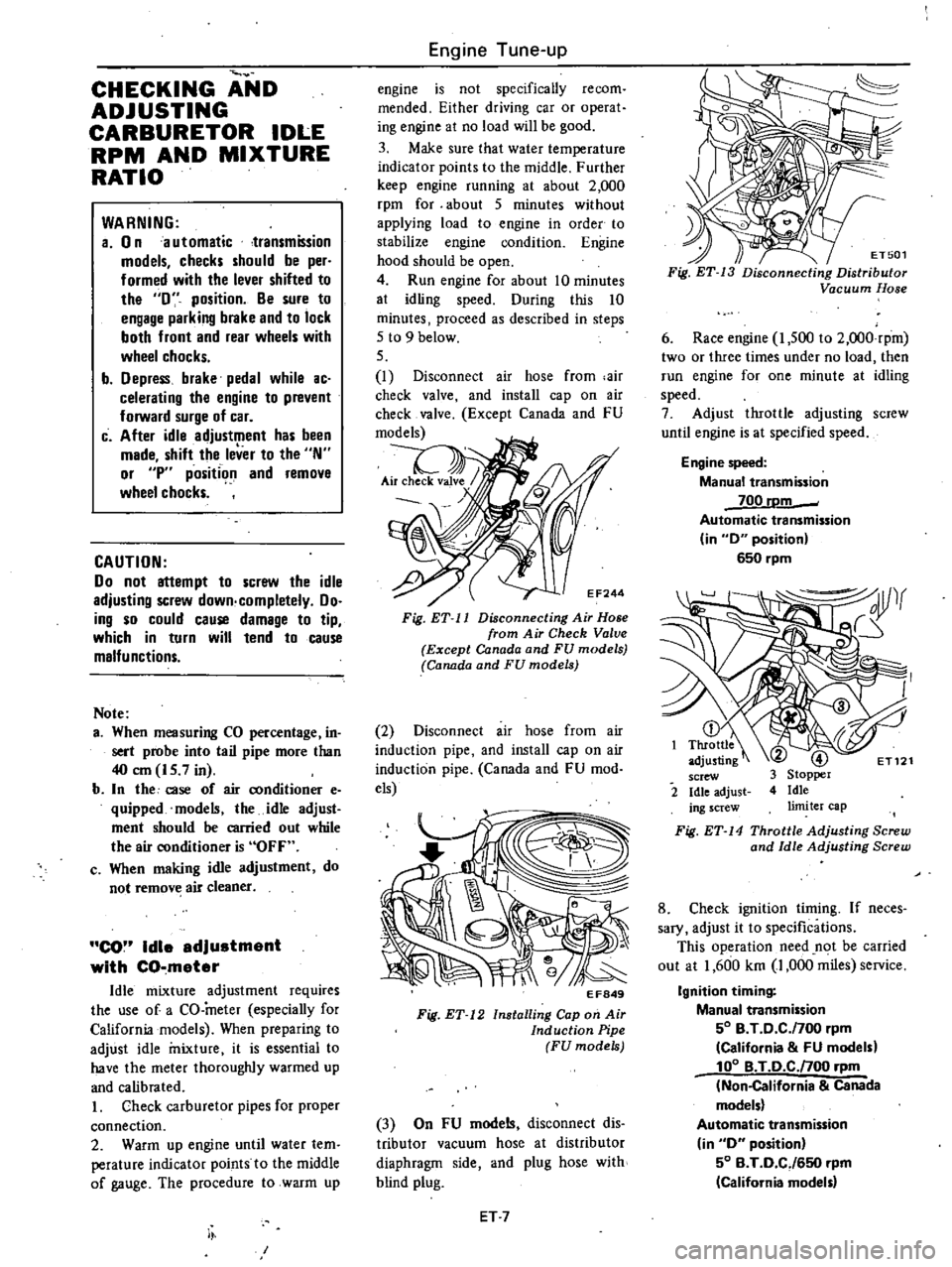
CHECKING
AND
ADJUSTING
CARBURETOR
IDLE
RPM
AND
MIXTURE
RATIO
WARNING
a
0
n
a
utomatic
transmission
models
checks
should
be
per
formed
with
the
lever
shifted
to
the
0
position
Be
sure
to
engage
parking
brake
and
to
lock
both
front
and
rear
wheels
with
wheel
chocks
b
Oepress
brake
pedal
while
ac
celerating
the
engine
to
prevent
forward
surge
of
car
c
After
idle
adjustment
has
been
made
shift
the
lever
to
the
N
or
P
positfon
and
remove
wheel
chocks
CAUTION
00
not
attempt
to
screw
the
idle
adjusting
screw
down
completely
00
ing
so
could
cause
damage
to
tip
which
in
turn
will
tend
to
cause
malfunctions
Note
a
When
measuring
CO
percentage
in
sert
probe
into
tail
pipe
more
than
40
cm
15
7
in
b
In
thee
case
of
air
conditioner
e
quipped
models
the
idle
adjust
ment
should
be
carried
out
while
the
air
conditioner
is
OFF
c
When
making
idle
adjustment
do
not
removt
air
cleaner
CO
Idle
adJustment
with
CO
meter
Idle
mixture
adjustment
requires
the
use
of
a
CO
meter
especially
for
California
models
When
preparing
to
adjust
idle
mixture
it
is
essential
to
have
the
meter
thoroughly
warmed
up
and
calibrated
1
Check
carburetor
pipes
for
proper
connection
2
Warm
up
engine
until
water
tern
perature
indicator
points
to
the
middle
of
gauge
The
procedure
to
warm
up
J
Engine
Tune
up
engine
is
not
specifically
recom
mended
Either
driving
car
or
operat
ing
engine
at
no
load
will
be
good
3
Make
sure
that
water
temperature
indicator
points
to
the
middle
Further
keep
engine
running
at
about
2
000
rpm
for
about
5
minutes
without
applying
load
to
engine
in
order
to
stabilize
engine
condition
Engine
hood
should
be
open
4
Run
engine
for
about
10
minutes
at
idling
speed
During
this
10
minutes
proceed
as
described
in
steps
5
to
9
below
5
I
Disconnect
air
hose
from
air
check
valve
and
install
cap
on
air
check
valve
Except
Canada
and
FU
models
EF244
Fig
ET
11
Disconnecting
Air
Hose
from
Air
Check
Valve
Except
Canada
and
FU
models
Canada
and
FU
models
2
Disconnect
air
hose
from
air
induction
pipe
and
install
cap
on
air
induction
pipe
Canada
and
FU
mod
els
EF849
Fig
ET
12
Installing
Cap
on
Air
Induction
Pipe
FU
models
3
On
FU
models
disconnect
dis
tributor
vacuum
hose
at
distributor
diaphragm
side
and
plug
hose
with
blind
plug
ET
7
ET501
Fig
ET
13
Disconnecting
Distributor
Vacuum
Hose
6
Race
engine
I
500
to
2
OOO
rpm
two
or
three
times
under
no
load
then
run
engine
for
one
minute
at
idling
speed
7
Adjust
throttle
adjusting
screw
until
engine
is
at
specified
speed
Engine
speed
Manual
transmission
700
rDm
Automatic
transmission
in
0
position
650
rpm
2
Fig
ET
14
Throttle
Adjusting
Screw
and
Idle
Adjusting
Screw
8
Check
ignition
timing
If
neces
sary
adjust
it
to
specifications
This
operation
need
n
t
be
carried
out
at
1
600
km
1
000
miles
service
Ignition
timing
Manual
transmission
50
B
T
0
C
f700
rpm
California
FU
models
100
B
T
O
C
noo
rpm
Non
California
Canada
models
Automatic
transmission
in
0
position
50
B
T
0
CJ650
rpm
California
model
Page 22 of 548
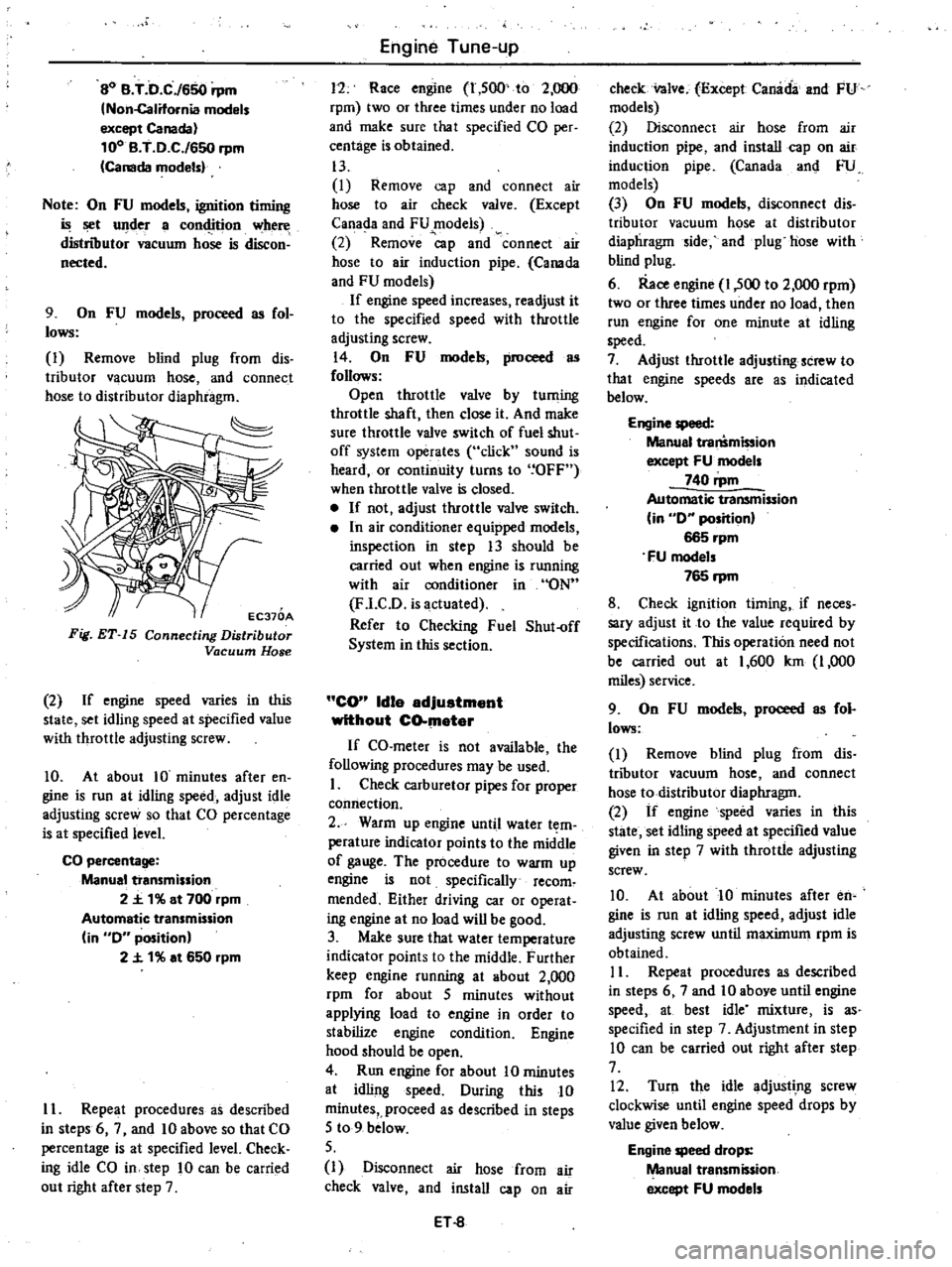
SO
B
T
D
C
650
rpm
Non
California
models
except
Canada
100
B
T
0
C
650
rpm
Canada
models
Note
On
FU
models
ignition
timing
t
under
a
con4ition
where
distnoutor
vacuum
hose
is
discon
nected
9
On
FU
models
proceed
as
fol
lows
I
Remove
blind
plug
from
dis
tributor
vacuum
hose
and
connect
hose
to
distributor
diaphragm
EC370A
Fig
ET
15
Connecting
Distributor
Vacuum
Hose
2
If
engine
speed
varies
in
this
state
set
idling
speed
at
specified
value
with
throttle
adjusting
screw
10
At
about
10
minutes
after
en
gine
is
run
at
idling
speed
adjust
idle
adjusting
screw
so
that
CO
percentage
is
at
specified
level
CO
percentage
Manual
transmission
2
t
1
at
700
rpm
Automatic
transmission
in
0
position
2
t
1
at
650
rpm
II
Repeat
procedures
as
described
in
steps
6
7
and
10
above
so
that
CO
percentage
is
at
specified
level
Check
ing
idle
CO
in
step
10
can
be
carried
out
right
after
step
7
Engine
Tune
up
11
Race
engine
1
500
to
2
000
rpm
two
or
three
times
under
no
load
and
make
sure
that
specified
CO
per
centage
is
obtained
13
I
Remove
cap
and
connect
air
hose
to
air
check
valve
Except
Canada
and
FU
models
2
Remove
p
and
connect
air
hose
to
air
induction
pipe
Canada
and
FU
models
If
engine
speed
increases
readjust
it
to
the
specified
speed
with
throttle
adjusting
screw
14
On
FU
models
proceed
as
follows
Open
throttle
valve
by
tuming
throttle
shaft
then
close
it
And
make
sure
throttle
valve
switch
of
fuel
shut
off
system
operates
click
sound
is
heard
or
continuity
turns
to
OFF
when
throttle
valve
is
closed
If
not
adjust
throttle
valve
switch
In
air
conditioner
equipped
models
inspection
in
step
13
should
be
carried
out
when
engine
is
running
with
air
conditioner
in
ON
F
l
CD
is
actuated
Refer
to
Checking
Fuel
Shut
off
System
in
this
section
CO
Idle
adjuatment
without
CO
mater
If
CO
meter
is
not
available
the
following
procedures
may
be
used
I
Check
carburetor
pipes
for
proper
comiection
2
Warm
up
engine
until
water
t
m
perature
indicator
points
to
the
middle
of
gauge
The
procedure
to
warm
up
engine
is
not
specifically
recom
mended
Either
driving
car
or
operat
ing
engine
at
no
load
will
be
good
3
Make
sure
that
water
temperature
indicator
points
to
the
middle
Further
keep
engine
running
at
about
2
000
rpm
for
about
5
minutes
without
applying
load
to
engine
in
order
to
stabilize
engine
condition
Engine
hood
should
be
open
4
Run
engine
for
about
10
minutes
at
idling
speed
During
this
10
minutes
proceed
as
described
in
steps
5
to
9
below
5
I
Disconnect
air
hose
from
air
check
valve
and
install
cap
on
air
ET
8
check
nlve
Except
Canada
and
FU
models
2
Disconnect
air
hose
from
air
induction
pipe
and
install
cap
on
air
induction
pipe
Canada
an
FU
models
3
On
FU
models
disconnect
dis
tributor
vacuum
hose
at
distributor
diaphragm
ide
and
plug
hose
with
blind
plug
6
Race
engine
1
500
to
2
000
rpm
two
or
three
times
under
no
load
then
run
engine
for
one
minute
at
idling
speed
7
Adjust
throttle
adjusting
screw
to
that
engine
speeds
are
as
indicated
below
Engine
speed
Manual
tra
mi
ion
except
FU
models
740
rpm
Automatic
transmission
in
0
position
665
rpm
FU
models
765
rpm
8
Check
ignition
timing
if
neces
sary
adjust
it
to
the
value
required
by
specifications
This
operation
need
not
be
carried
out
at
1
600
km
1
000
miles
service
9
On
FU
models
proceed
as
fol
lows
I
Remove
blind
plug
from
dis
tributor
vacuum
hose
and
connect
hose
to
distributor
diaphragm
2
If
engine
speed
varies
in
this
state
set
idling
speed
at
specified
value
given
in
step
7
with
throttle
adjusting
screw
10
At
about
10
minutes
after
en
gine
is
run
at
idling
speed
adjust
idle
adjusting
screw
until
maximum
rpm
is
obtained
II
Repeat
procedures
as
described
in
steps
6
7
and
10
above
until
engine
speed
at
best
idle
mixture
is
as
specified
in
step
7
Adjustment
in
step
10
can
be
carried
out
right
after
step
7
12
Turn
the
idle
adjustIng
screw
clockwise
until
engine
speed
drops
by
value
given
below
Engine
speed
drops
Manual
transmission
except
FU
models
Page 23 of 548
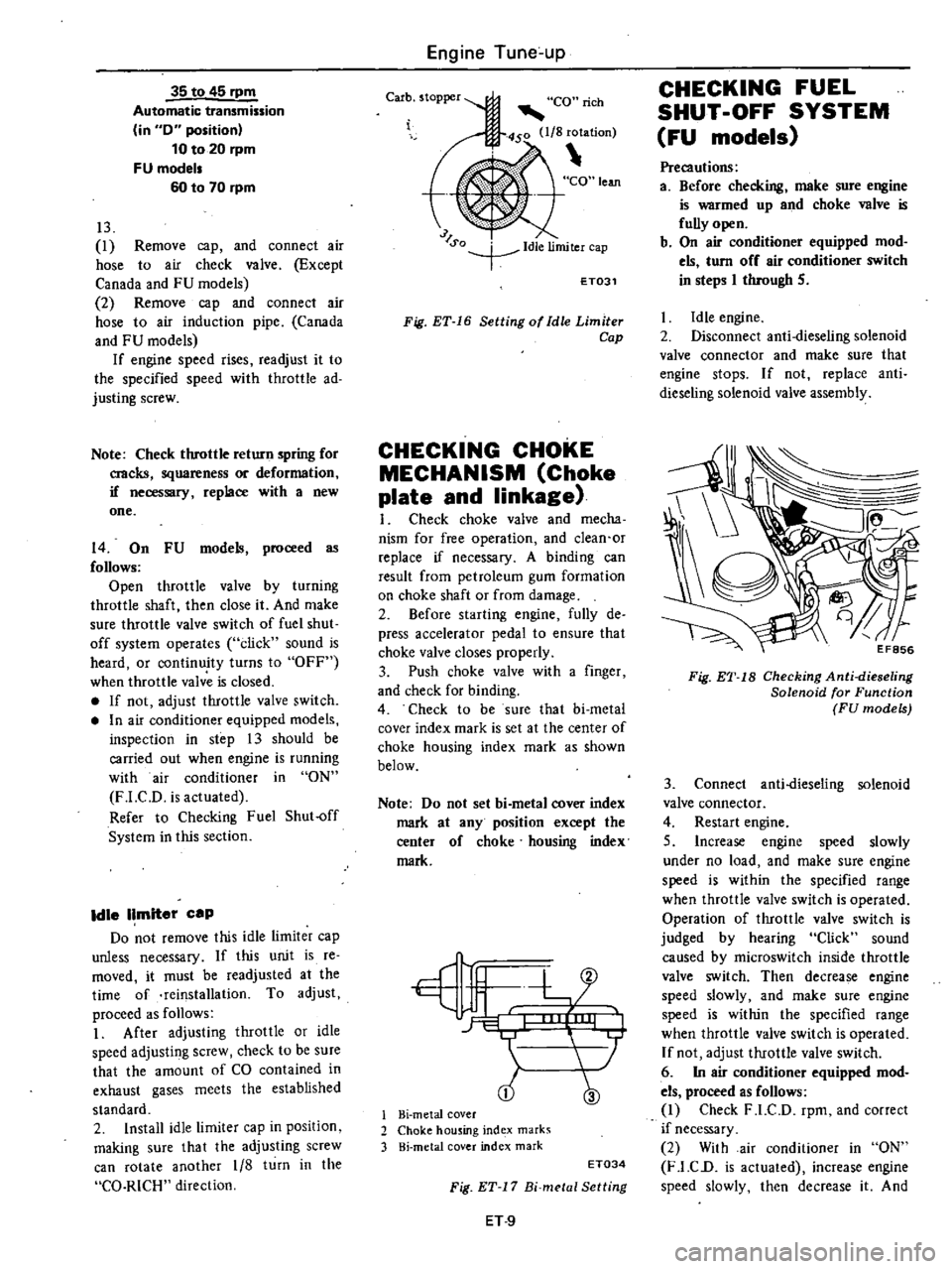
35
to
45
pm
Automatic
transmission
in
60
position
10
to
20
pm
FU
model
60
to
70
rpm
13
I
Remove
cap
and
connect
air
hose
to
air
check
valve
Except
Canada
and
FU
models
2
Remove
cap
and
connect
air
hose
to
air
induction
pipe
Canada
and
FU
models
If
engine
speed
rises
readjust
it
to
the
specified
speed
with
throttle
ad
justing
screw
Note
Check
throttle
return
spring
for
CI3cks
squareness
or
deformation
if
necessary
replace
with
a
new
one
14
On
FU
models
proceed
as
follows
Open
throttle
valve
by
turning
throttle
shaft
then
close
it
And
make
sure
throttle
valve
switch
of
fuel
shut
off
system
operates
click
sound
is
heard
or
continuity
turns
to
OFF
when
throttle
valv
is
closed
If
not
adjust
throttle
valve
switch
In
air
conditioner
equipped
models
inspection
in
step
13
should
be
carried
out
when
engine
is
running
with
air
conditioner
in
ON
F
I
C
D
is
actuated
Refer
to
Checking
Fuel
Shut
off
System
in
this
section
Idle
limiter
cap
Do
not
remove
this
idle
limiter
cap
unless
necessary
If
this
unit
is
re
moved
it
must
be
readjusted
at
the
time
of
reinstallation
To
adjust
proceed
as
follows
I
After
adjusting
throttle
or
idle
speed
adjusting
screw
check
to
be
sure
that
the
amount
of
CO
contained
in
exhaust
gases
meets
the
established
standard
2
Install
idle
limiter
cap
in
position
making
sure
that
the
adjusting
screw
can
rotate
another
1
8
turn
in
the
CO
RICH
direction
Engine
Tune
up
CO
rich
l
8
rotation
CO
lean
ISo
Idle
limiter
cap
ET031
Fig
ET
16
Setting
of
Idle
Limiter
Cap
CHECKING
CHOKE
MECHANISM
Choke
plate
and
linkage
I
Check
choke
valve
and
mecha
nism
for
free
operation
and
clean
or
replace
if
necessary
A
binding
can
result
from
petroleum
gum
formation
on
choke
shaft
or
from
damage
2
Sefore
starting
engine
fully
de
press
accelerator
pedal
to
ensure
that
choke
valve
closes
properly
3
Push
choke
valve
with
a
finger
and
check
for
binding
4
Check
to
be
sure
that
bi
metal
cover
index
mark
is
set
at
the
center
of
choke
housing
index
mark
as
shown
below
Note
Do
not
set
bi
metal
cover
index
mark
at
any
position
except
the
center
of
choke
housing
index
mark
tfljlL
L
i
05
1
Hi
metal
cover
2
Choke
housing
ind
x
marks
3
Hi
metal
cover
index
mark
ET034
Fig
ET
17
Bi
metal
Setting
ET
9
CHECKING
FUEL
SHUT
OFF
SYSTEM
FU
models
Precautions
a
Before
checking
make
sure
engine
is
warmed
up
and
choke
valve
is
fully
open
b
On
air
conditioner
equipped
mod
els
turn
off
air
conditioner
switch
in
steps
I
through
S
Idle
engine
2
Disconnect
anti
dieseling
solenoid
valve
connector
and
make
sure
that
engine
stops
If
not
replace
anti
dieseling
solenoid
valve
assembly
Fig
ET
18
Checking
Anti
dieseling
Solenoid
for
Function
FU
models
3
Connect
anti
dieseling
solenoid
valve
connector
4
Restart
engine
S
Increase
engine
speed
slowly
under
no
load
and
make
sure
engine
speed
is
within
the
specified
range
when
throttle
valve
switch
is
operated
Operation
of
throttle
valve
switch
is
judged
by
hearing
Click
sound
caused
by
microswitch
inside
throttle
valve
switch
Then
decrease
engine
speed
slowly
and
make
sure
engine
speed
is
within
the
specified
range
when
throttle
valve
switch
is
operated
If
not
adjust
throttle
valve
switch
6
In
air
conditioner
equipped
mod
els
proceed
as
follows
1
Check
F
1
C
D
rpm
and
correct
if
necessary
2
With
air
conditioner
in
ON
F
l
C
D
is
actuated
increase
engine
speed
slowly
then
decrease
it
And
Page 24 of 548
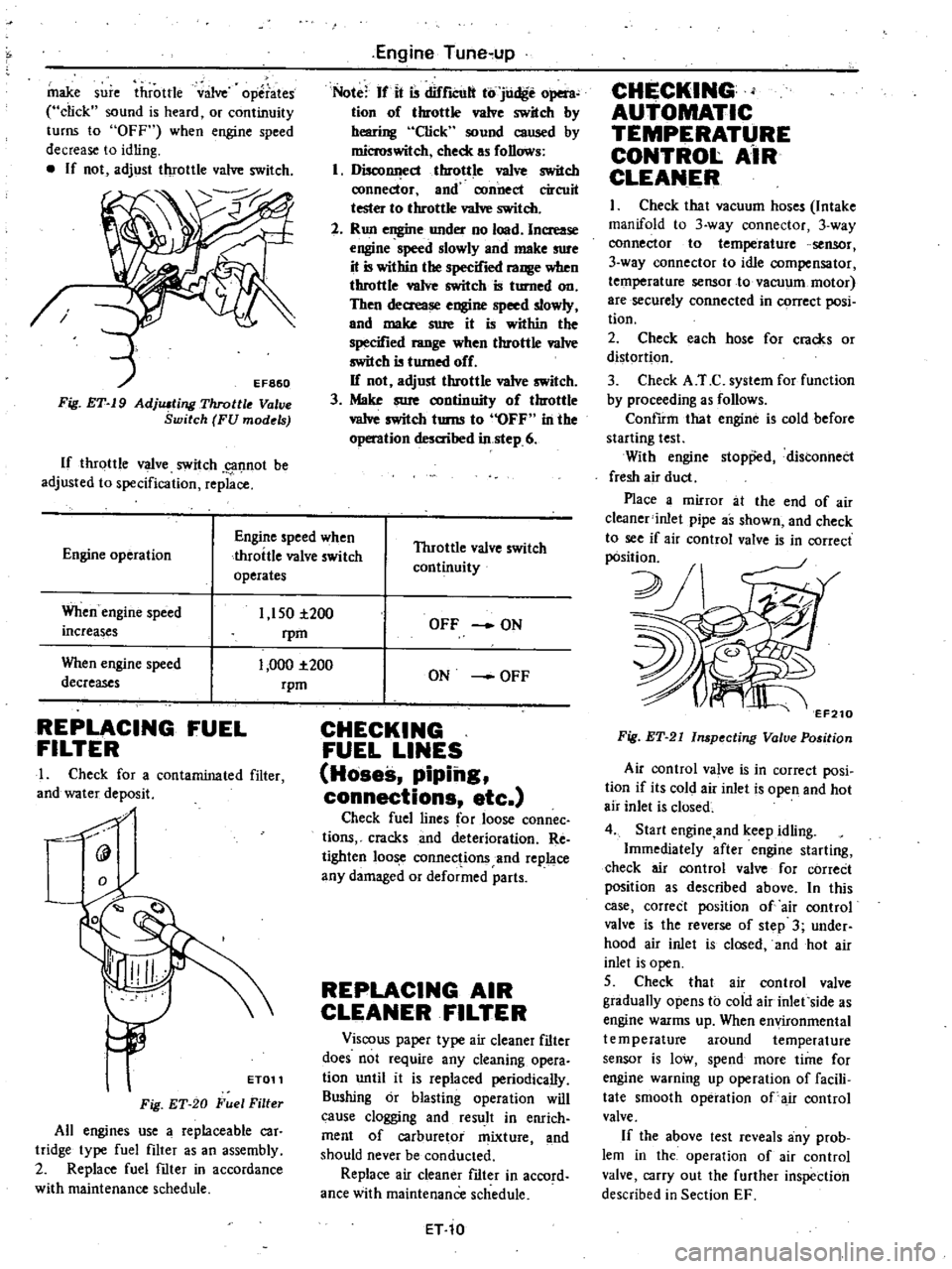
make
sure
throttle
valve
operates
click
sound
is
heard
or
continuity
turns
to
OFF
when
engine
speed
decrease
to
idling
If
not
adjust
throttle
valve
switch
Fig
ET
19
AdjlUting
Throttle
V
ve
Switch
FU
models
If
throttle
valve
switch
g1f1not
be
adjusted
to
specification
replace
Engine
Tune
up
Note
If
it
is
difrlCUlt
to
judge
open
tion
of
throttle
valve
switch
by
hearing
Click
sound
caused
by
microswitch
check
as
follows
1
DiscollI
ecl
throttle
va1ve
switch
ronnector
and
connect
circuit
tester
to
throttle
va1ve
switch
2
Run
engine
under
no
load
Increase
engine
speed
slowly
and
make
sure
it
is
within
the
specified
range
when
throttle
valve
switch
is
turned
on
Then
decrease
engine
speed
slowly
and
make
sure
it
is
within
the
specified
range
when
throttle
va1ve
switch
is
turned
off
If
not
adjust
throttle
valve
switch
3
Make
sure
continuity
of
throttle
vaIve
switch
turns
to
OFF
in
the
operation
desaihed
in
step
6
Engine
operation
Engine
speed
when
throttle
valve
switch
operates
Throttle
valve
switch
continuity
When
engine
speed
increases
1
150
i200
rpm
1
000
1
200
rpm
When
engine
speed
decreases
REPLACING
FUEL
FILTER
I
Check
for
a
contaminated
filter
and
water
deposit
0
9
ET011
Fig
ET
20
Fuel
Filter
All
engines
use
a
replaceable
car
tridge
type
fuel
filter
as
an
assembly
2
Replace
fuel
filter
in
accordance
with
maintenance
schedule
OFF
ON
ON
OFF
CHECKING
FUEL
LINES
Hoses
piping
connections
etc
Check
fuel
lines
for
loose
connec
tions
cracks
and
deterioration
Re
tighten
loose
connections
and
replace
any
damaged
or
deformed
parts
REPLACING
AIR
CLEANER
FILTER
Viscous
paper
type
air
cleaner
filter
does
not
require
any
cleaning
opera
tion
until
it
is
replaced
periodically
Sushing
or
blasting
operation
will
cause
clogging
and
result
in
enrich
ment
of
carburetor
mixture
and
should
never
be
conducted
Replace
air
cleaner
filter
in
accord
ance
with
maintenance
schedule
ET
10
CHECKING
AUTOMATIC
TEMPERATURE
CONTROl
AiR
CLEANER
I
Check
that
vacuum
hoses
Intake
manifold
to
3
way
connector
3
way
connector
to
temperature
sensor
3
way
connector
to
idle
compensator
temperature
sensor
to
vacuum
motor
are
securely
connected
in
C9rrect
posi
tion
2
Check
each
hose
for
cracks
or
distortion
3
Check
A
T
C
system
for
function
by
proceeding
as
follows
ConfIrm
that
engine
is
cold
before
starting
test
With
engine
stopp
d
distonnect
fresh
air
duct
Place
a
mirror
at
the
end
of
air
c1eaner
inlet
pipe
as
shown
and
check
to
see
if
air
control
valve
is
in
correct
pOsition
2J
v
7
EF210
Fig
ET
21
Inspecting
Valve
Position
Air
control
va
ve
is
in
correct
posi
tion
if
its
cold
air
inlet
is
open
and
hot
air
inlet
is
closed
4
Start
engine
and
keep
idling
Immediately
after
engine
starting
check
air
control
valve
for
correCt
position
as
described
above
In
this
case
correct
position
of
air
control
valve
is
the
reverse
of
step
3
under
hood
air
inlet
is
closed
and
hot
air
inlet
is
open
5
Check
that
air
control
valve
gradually
opens
to
cold
air
inlet
side
as
engine
warms
up
When
environmental
temperature
around
temperature
sensor
is
low
spend
more
time
for
engine
warning
up
operation
of
facili
tate
smooth
operation
of
air
control
valve
If
the
above
test
reveals
any
prob
lem
in
the
operation
of
air
control
valve
carry
out
the
further
inspection
described
in
Section
EF
Page 25 of 548
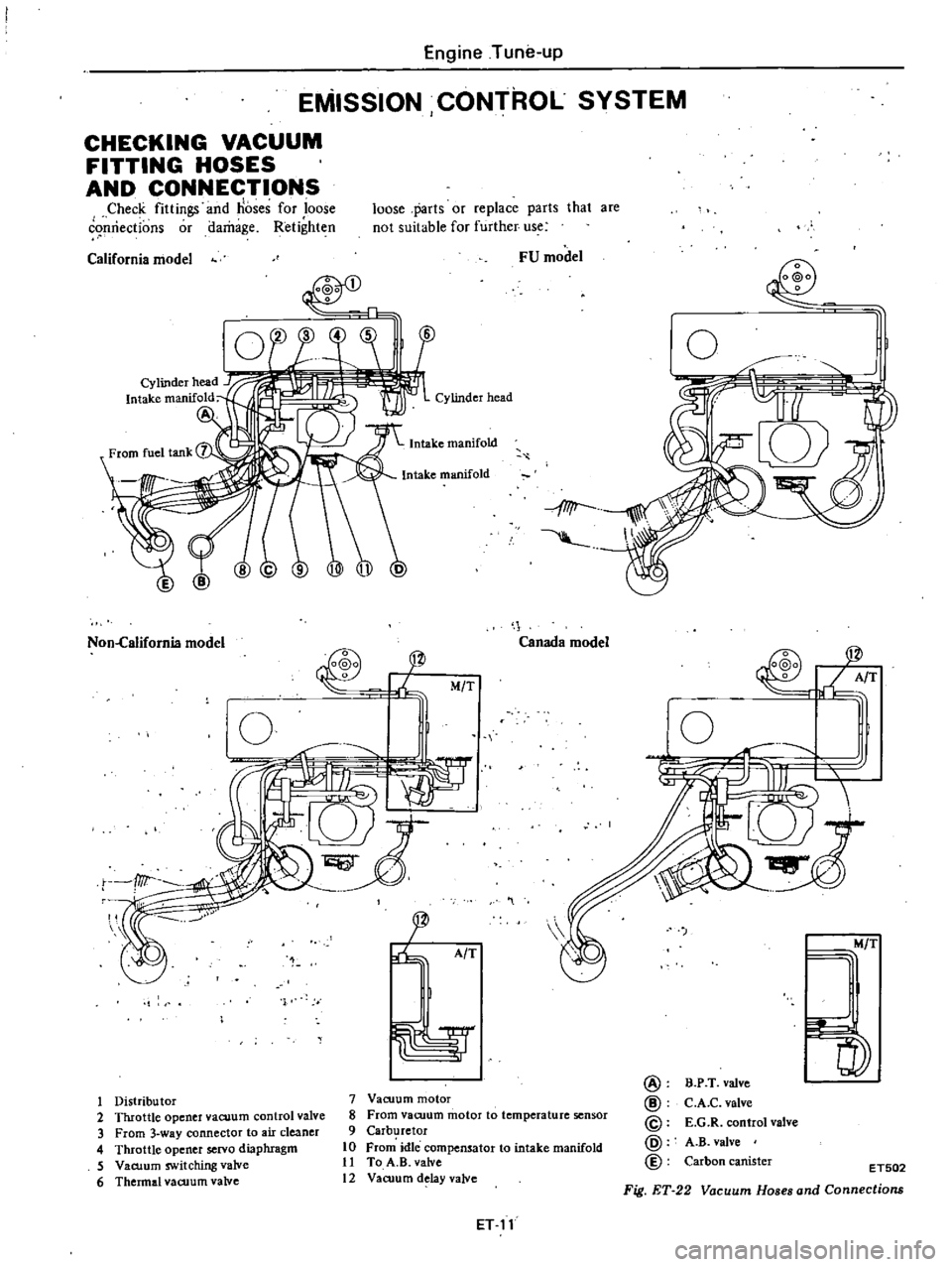
Engine
Tune
up
EMISSION
CONTROL
SYSTEM
CHECKING
VACUUM
FITTING
HOSES
AND
CONNECTIONS
Check
fittings
and
hoses
for
ioose
cqnriections
or
damage
Retighten
loose
parts
or
replace
parts
that
are
not
suitable
for
further
use
California
model
FU
model
w
fl11r
o
Intake
manifold
Non
California
model
q
Canada
model
@
T
J
I
M
T
r
T
r
o
p
1
o
1
J
1
Distributor
2
Throttle
opener
vaaJ
um
control
valve
3
From
3
way
connector
to
air
cleaner
4
Throttle
opener
servo
diaphragm
5
Vacuum
switching
valve
6
Thermal
v3roum
valve
7
Vacuum
motor
8
From
vacuum
motor
to
temperature
sensor
9
Carburetor
10
From
idle
compensator
to
intake
manifold
11
To
A
B
valve
12
Vacuum
d
lay
valve
@
@
@
@
@
B
P
T
valve
C
A
C
valve
E
G
R
control
valve
A
B
valve
Carbon
canister
M
T
l
Q2
A
T
ET502
Fig
ET
22
Vacuum
Hoses
and
Connections
ET
11
Page 26 of 548
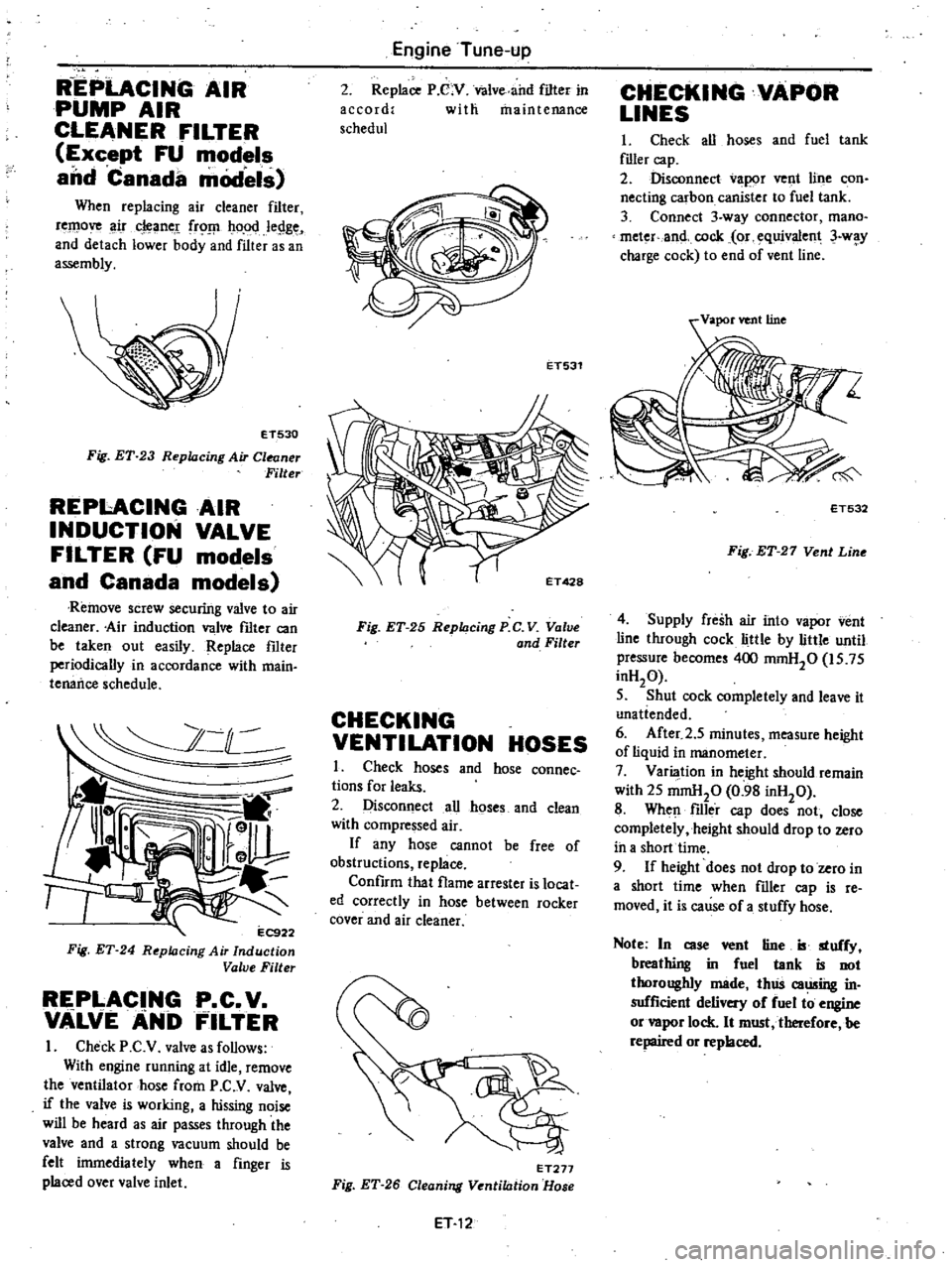
R
EPIACING
AIR
PUMP
AIR
CLEANER
FILTER
Except
FU
models
and
Canada
models
When
replacing
air
cleaner
filter
remove
ir
cleane
frO
ho
od
legge
and
detach
lower
body
and
filter
as
an
assembly
ET530
Fig
ET
23
Replacing
Air
Cleaner
Filter
REPI
ACINGAIR
INDUCTION
VALVE
FILTER
FU
models
and
Canada
models
Remove
screw
securirtg
valve
to
air
cleaner
Air
induction
valve
fIlter
can
be
taken
out
easily
Replace
fIlter
periodically
in
accordance
with
main
tenance
schedule
2
C
l
11
l
r
r
EC9
Fig
ET
24
R
pklcing
Air
Induction
Value
Filter
REPLACING
P
C
V
VALVEANb
FILTER
I
Check
P
C
V
valve
as
follows
With
engine
running
at
idle
remove
the
ventilator
hose
from
P
C
V
valve
if
the
valve
is
working
a
hissing
noise
will
be
heard
as
air
passes
through
the
valve
and
a
strong
vacuum
should
be
felt
inunediately
when
a
finger
is
placed
over
valve
inlet
Engine
Tune
up
2
Replace
P
C
V
Valve
and
filter
in
accord
with
maintenance
schedul
ET531
Fig
ET
25
Replacing
P
C
V
Value
and
Filter
CHECKING
VENTILATION
HOSES
I
Check
hoses
and
hose
connec
tions
for
leaks
2
Disconnect
all
hoses
and
clean
with
compressed
air
If
any
hose
cannot
be
free
of
obstructions
replace
Confirm
that
flame
arrester
is
locat
ed
correctly
in
hose
between
rocker
cover
and
air
cleaner
ET277
Fig
ET
26
Cleaning
Ventilation
Hose
ET
12
CHECKING
VAPOR
LINES
I
Check
all
hoses
and
fuel
tank
flller
cap
2
Disconnect
vapor
vent
line
con
necting
carbon
canister
to
fuel
tank
3
Connect
3
way
connector
mana
meter
and
cock
or
equivalent
3
w
y
charge
cock
to
end
of
vent
line
ET532
Fig
ET
27
Vent
Line
4
Supply
fresh
air
into
vapor
vent
line
through
cock
little
by
little
until
pressure
become
400
mmH20
is
75
inH20
5
Shut
cock
completely
and
leave
it
unatiended
6
After
2
5
minutes
measure
height
of
liquid
in
manometer
7
Varilllion
in
height
should
remain
with
25
mmHp
0
98
inH20
8
When
filler
cap
does
not
close
completely
height
should
drop
to
zero
ih
a
short
time
9
If
height
does
not
drop
to
zero
in
a
short
time
when
filler
cap
is
re
moved
it
is
cause
of
a
stuffy
hose
Note
In
case
vent
tine
B
stuffy
breathing
in
fuel
tank
is
not
thoroughly
made
thlis
caming
in
sufficient
delivery
of
fuel
to
engine
or
vapor
lock
It
must
tberefore
be
repaired
or
replaced
Page 27 of 548
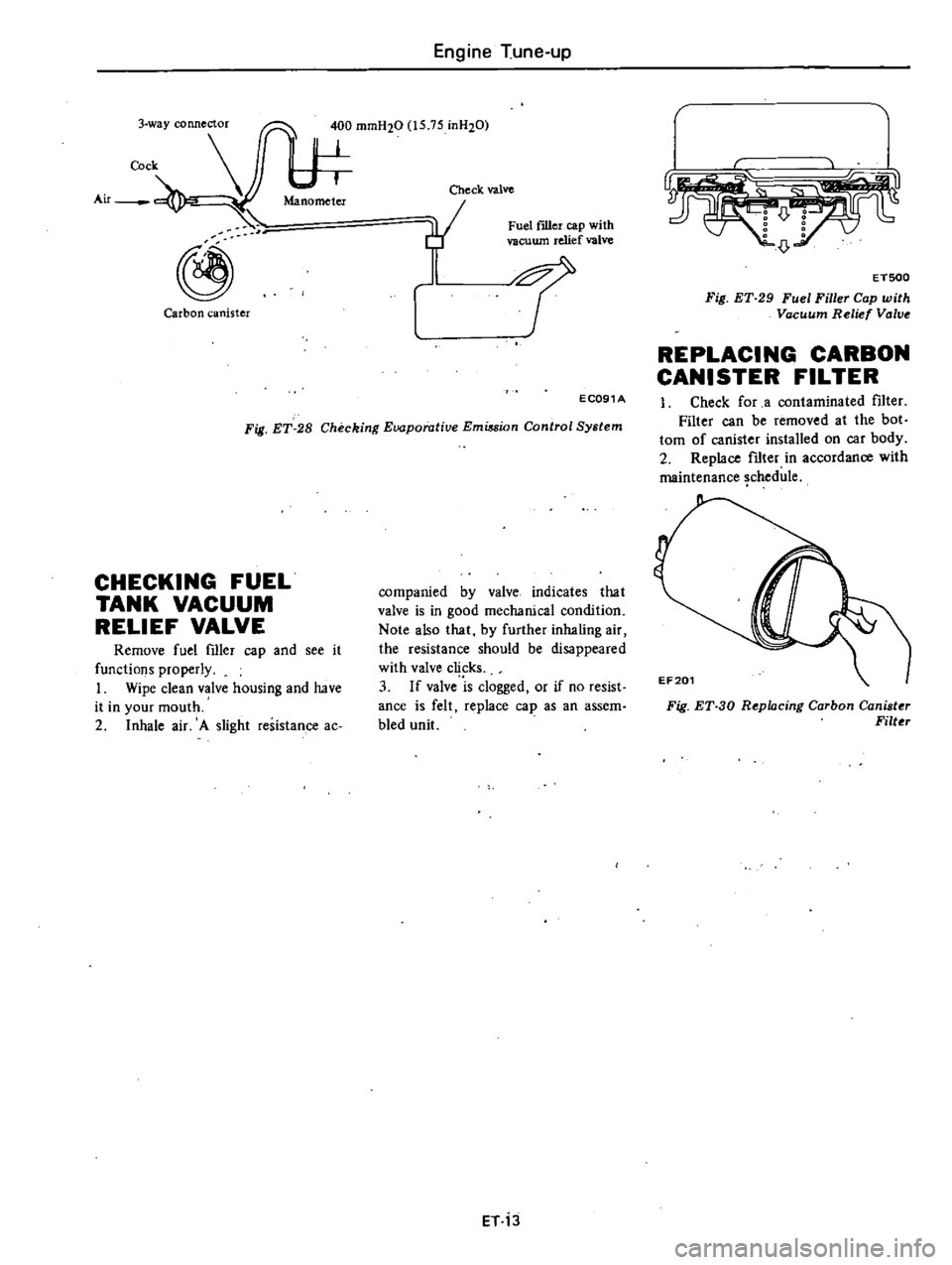
3
way
connector
ck
Air
Manometer
@
Carbon
canister
Engine
Tune
up
400
mmH20
15
75
in
H20
Check
valve
r
F
uel
filler
cap
with
vacuum
relief
valve
1
Fig
ET
28
Checking
Evaporatiue
Emiuion
Control
System
EC091A
CHECKING
FUEL
TANK
VACUUM
RELIEF
VALVE
Remove
fuel
filler
cap
and
see
it
functions
properly
I
Wipe
clean
valve
housing
and
have
it
in
your
mouth
2
Inhale
air
A
slight
resistance
ac
companied
by
valve
indicates
that
valve
is
in
good
mechanical
condition
Note
also
that
by
further
inhaling
air
the
resistance
should
be
disappeared
with
valve
c
ks
3
If
valve
is
clogged
or
if
no
resist
ance
is
felt
replace
cap
as
an
assem
bled
unit
ET
j3
D
o
0
o
0
o
0
ET500
Fig
ET
29
Fuel
Filler
Cap
with
Vacuum
Relief
Value
REPLACING
CARBON
CANISTER
FILTER
Check
for
a
contaminated
fJlter
Filter
can
be
removed
at
the
bot
tom
of
canister
installed
on
car
body
2
Replace
fJlter
in
accordance
with
maintenance
chedule
EF201
Fig
ET
30
Repfucing
Carbon
Canister
Filter
Page 28 of 548
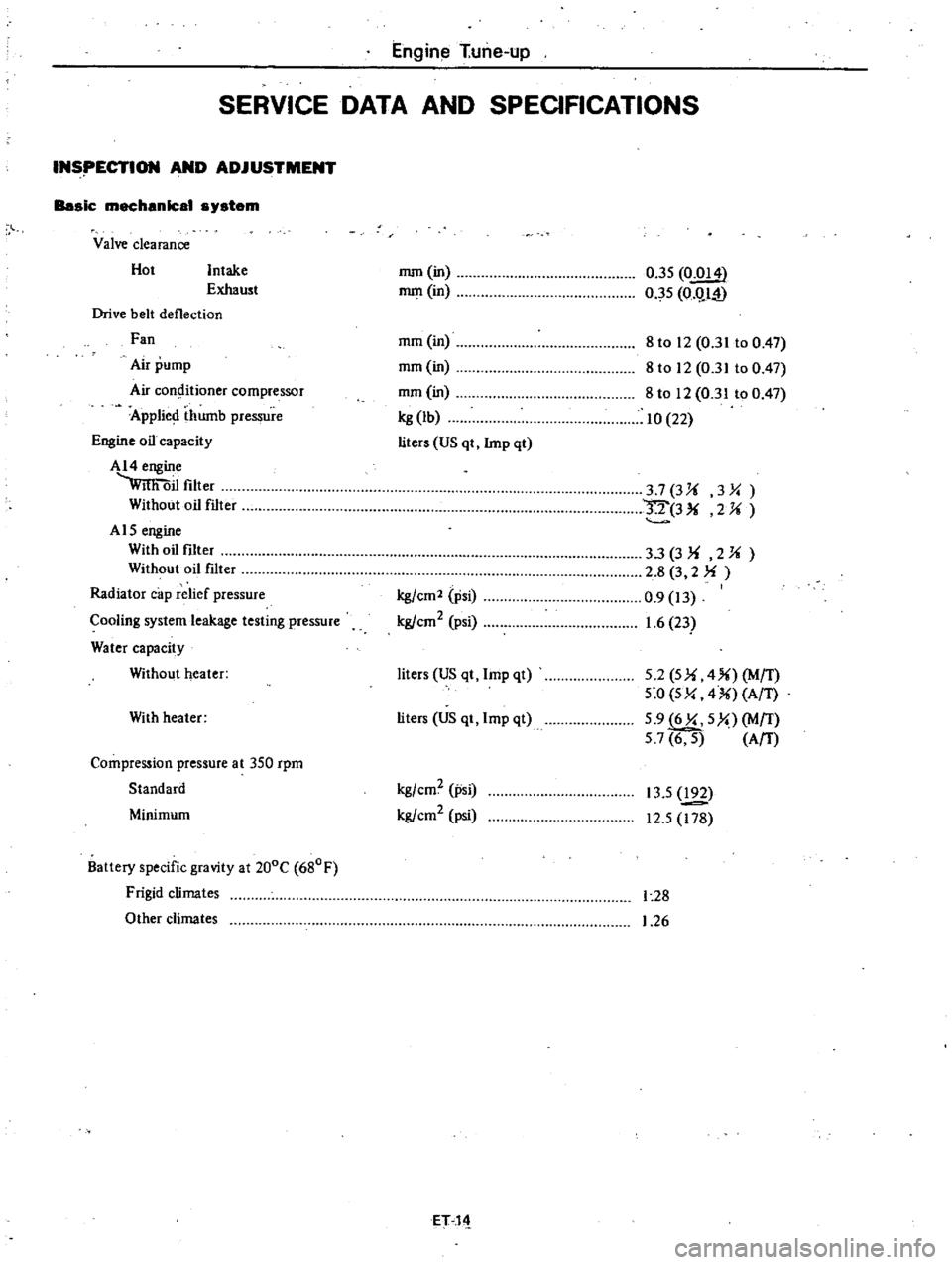
Engine
T
une
up
SERVICE
DATA
AND
SPECIFICATIONS
INSpECTION
AND
ADJUSTMENT
Basic
mechanical
s
stem
Valve
clearance
Hot
Intake
Exhaust
Drive
belt
deflection
Fan
Air
pump
Air
COo9itioner
compressor
Applied
thumb
pressure
Engine
oil
capacity
AI4
engine
wmi
oil
filter
Without
oil
filter
A
15
engine
With
oil
fIlter
Without
oil
filter
Radiator
cap
relief
pressure
Cooling
system
leakage
testing
pressure
Water
capacity
Without
heater
With
heater
Compression
pressure
at
350
rpm
Standard
Minimum
Battery
specific
gravity
at
200C
680F
Frigid
climates
Other
climates
mm
in
mm
in
0
35
0
014
0
5
O
QI
i
mm
in
mm
in
mm
in
kg
lb
liters
US
qt
lmp
qt
8
to
12
0
31
to
0
47
8
to
12
0
31
to
0
47
8
to
12
0
31
to
0
47
10
22
37
3Ji
3
Y
IT
3
2Ji
kgfcm2
psi
kg
cm2
psi
33
3
Ji
2
Ji
2
8
3
2
f
0
9
13
1
6
23
liters
US
qt
lmp
qt
5
2
5
f
4
MfT
5
0
5Y
4
AfT
5
9
6Y
5
MfT
57
6
5
AfT
liters
US
qt
lmp
qt
kgfcm2
psi
kgfcm2
psi
13
5
192
12
5
178
1
28
1
26
ET11
Page 29 of 548
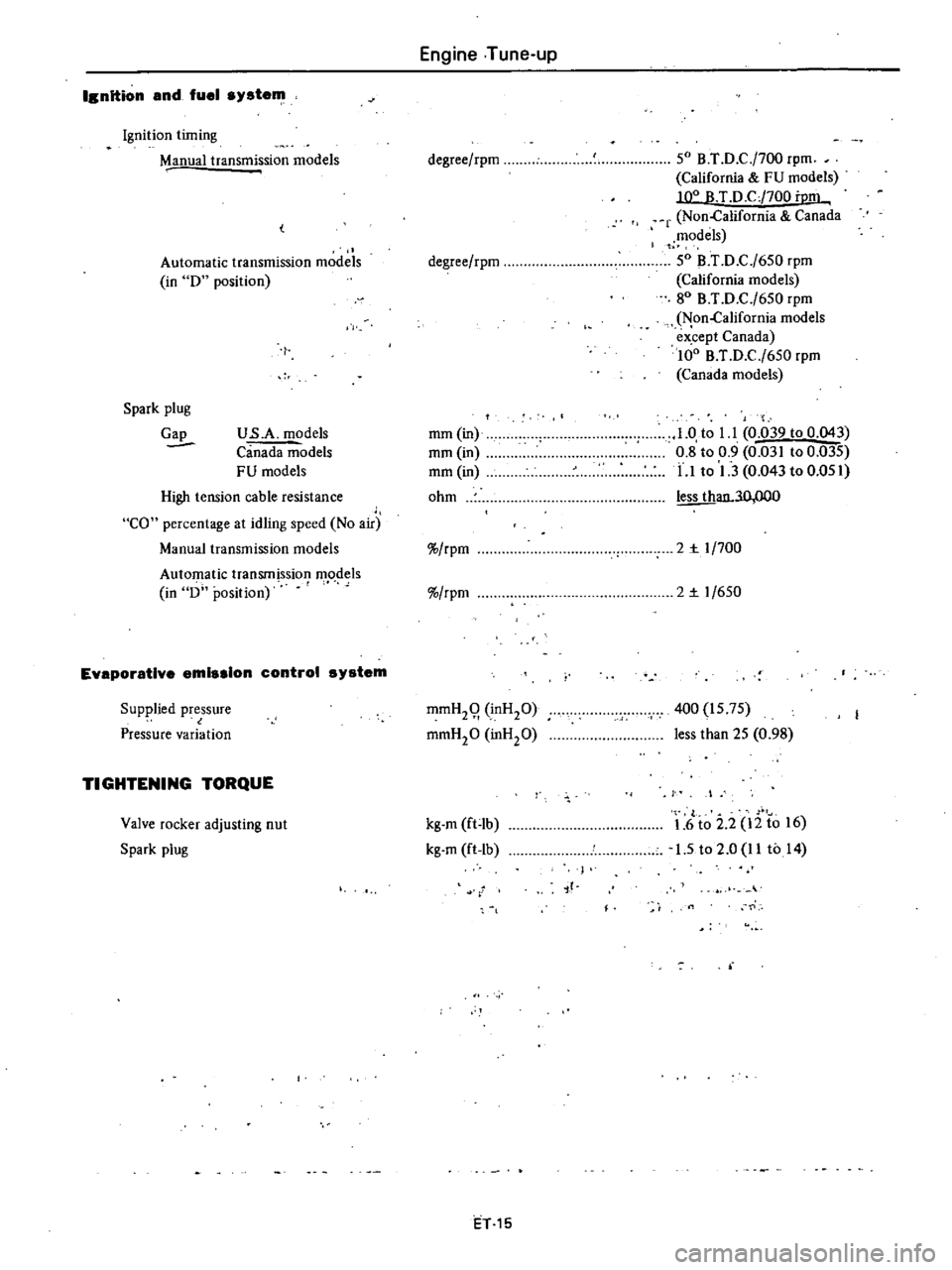
IBnition
and
fuel
system
Ignition
timing
Manual
transmission
models
Automatic
transmission
models
in
D
position
1
Spark
plug
Gap
U
s
A
models
Canada
models
FU
models
High
tension
cable
resistance
CO
percentage
at
idling
speed
No
air
Manual
transmission
models
Automatic
transmission
models
f
in
D
position
Evaporatlv
emission
control
system
Supplied
pressure
l
Pressure
variation
TIGHTENING
TORQUE
Valve
rocker
adjusting
nut
Spark
plug
Engine
Tune
up
degree
rpm
degree
rpm
mm
in
mm
in
mm
in
ohm
rpm
rpm
mmH29
inH20
mmH20
inHP
kg
m
ft
lb
kg
m
ft
lb
ET1S
SO
B
T
D
C
j700
rpm
California
FU
models
T
D
CJ700
i
m
r
Non
California
Canada
models
SO
B
T
D
C
j6S0
rpm
California
models
80
B
T
D
C
j6S0
rpm
Non
California
models
ex
cept
Canada
100
B
T
D
C
j6S0
rpm
Canada
models
1
0
to
l
l
0
039
to
0
043
0
8
to
0
9
0
031
to
0
035
LI
to
1
3
0
043
to
O
OSI
an
3O
OOO
2
r
1
700
2
r
1
6S0
400
IS
7S
less
than
2S
0
98
I
f
r
1
6
to
2
2
12
to
16
1
5
to
2
0
11
to
14
jf
0
Page 30 of 548
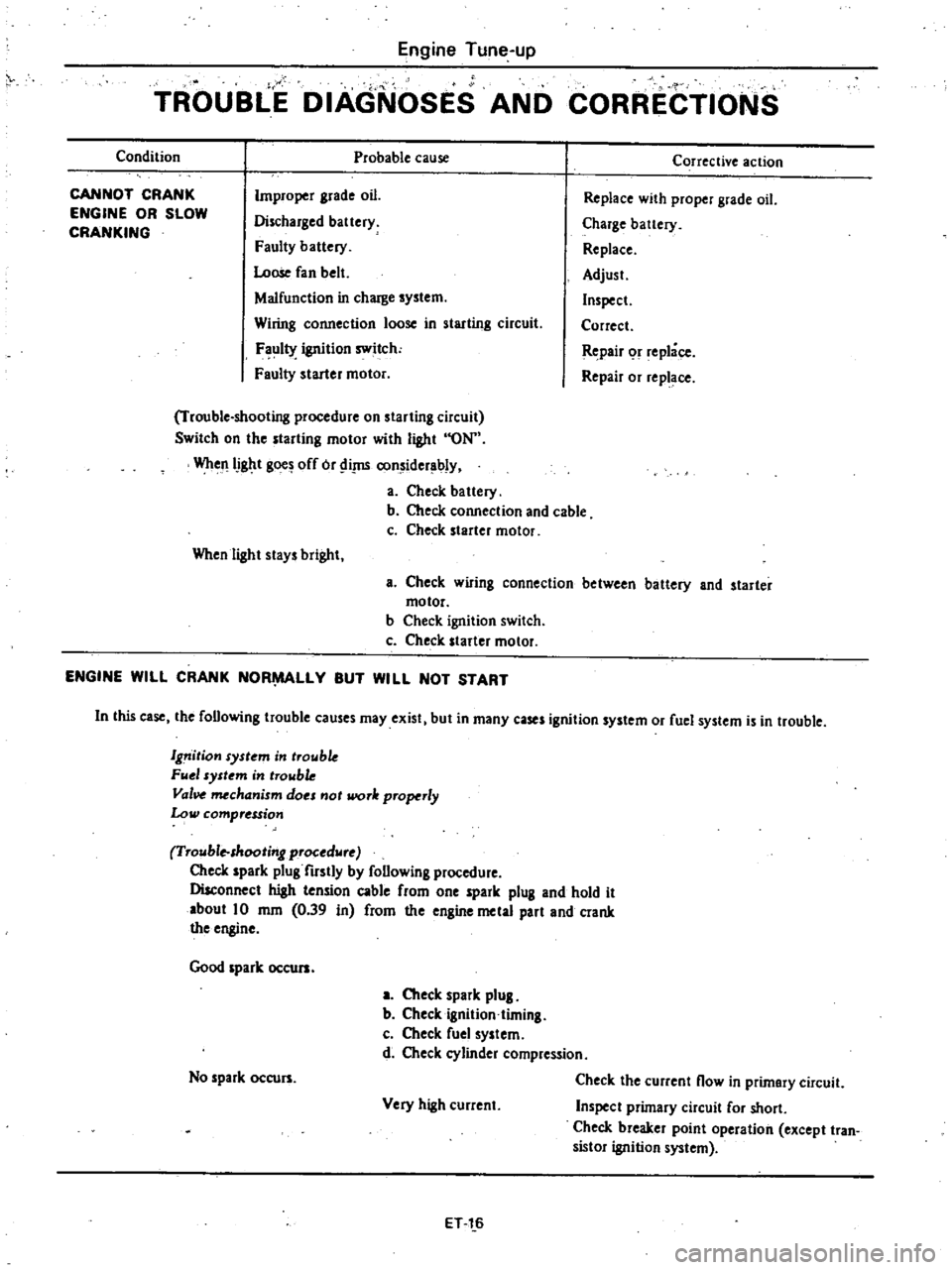
Engine
Tune
up
TROUBLE
DIAGNOSES
AND
CORRECTIONS
Condition
Probable
cause
CANNOT
CRANK
ENGINE
OR
SLOW
CRANKING
Improper
grade
oil
Discharged
battery
Faulty
battery
Loose
fan
belt
Malfunction
in
charge
system
Wiring
connection
loose
in
starting
circuit
F
ul1Y
ignition
switch
Faulty
starter
motor
Trouble
shooting
procedure
on
starting
circuit
Switch
on
the
starting
motor
with
light
ON
WheJlIJght
gOO
off
or
Ii
J1S
considerably
a
Check
battery
b
Check
connection
and
cable
c
Check
starter
motor
When
light
stays
bright
Corrective
action
Replace
with
proper
grade
oil
Charge
battery
Replace
Adjust
Inspect
Correct
Repair
or
replace
Repair
or
replace
a
Check
wlflng
connection
between
battery
and
starter
motor
b
Check
ignition
switch
c
Check
starter
motor
ENGINE
WILL
CRANK
NOR
LLY
BUT
WILL
NOT
START
In
this
case
the
following
trouble
causes
may
exist
but
in
many
cases
ignition
system
or
fuel
system
is
in
trouble
19
ition
syst
m
in
trouble
FII
1
system
in
trowb
Val
mechanism
do
not
work
properly
Low
compression
Trouble
shooting
procedure
Check
spark
plug
firstly
by
following
procedure
Disconnect
high
tension
cable
from
one
spark
plug
and
hold
it
about
10
mm
0
39
in
from
the
engine
metal
part
and
crank
the
engine
Good
spark
occurs
a
Check
spark
plug
b
Checkignition
timing
c
Check
fuel
system
d
Check
cylinder
compression
Check
the
current
now
in
primary
circuit
Very
high
current
Inspect
primary
circuit
for
short
Check
breaker
point
operation
except
tran
sistor
ignition
system
No
spark
occurs
ET
l
6